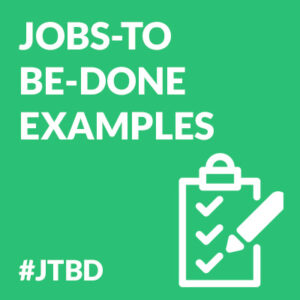 The jobs-to-be-done framework is the most trendy innovation framework at the moment.
The jobs-to-be-done framework is the most trendy innovation framework at the moment.
Why?
It helps to understand what causes people to buy a particular product.
You can use it in two ways:
1. To understand what people want in a specific market;
2. To create a compelling customer experience.
In this article, you’ll see a few examples of jobs to be done.
This will help you understand how to uncover the needs and desires of a market using the job. And how to think about the benefits and customer experience that should shape your value proposition.
What does “Jobs to Be Done” mean?
The jobs-to-be-done framework uses “jobs” as a metaphor to explain what people are trying to achieve when they buy something.
Here’s a good definition of a job to be done :
“A job is the progress a customer seeks in a particular context.”
Another way to think about jobs to be done is to see them as the things customers are trying to achieve in very specific circumstances.

In Competing Against Luck, Clayton Christen adds:
“This definition is specific and important: Fully understanding a customer’s job requires understanding the progress a customer is trying to make in particular circumstances and understanding all of its functional, social, and emotional dimensions—as well as the trade-offs the customer is willing to make.”
People do not just buy a product or service. What are they trying to get done?
They “hire” them to make progress.
The Job Theory: A way to put the customer in the centre
The “job” metaphor forces us to focus on the customer. It emphasises the progress they are trying to achieve. We’re then less likely to think about the product first.
Christensen explains this in an article called Marketing Malpractice:
“Theodore Levitt used to tell his students:
‘People don’t want to buy a quarter-inch drill. They want a quarter-inch hole!’
Every marketer we know agrees with Levitt’s insight. Yet these same people segment their markets by type of drill and by price point; they measure market share of drills, not holes; and they benchmark the features and functions of their drill, not their hole, against those of rivals.”
— Clayton Christensen, author of Competing Against Luck
As an alternative to the concept of “jobs to be done”, I prefer using the term “goals“. I dig into that in The Value Mix. I have found it makes it easier to explain the concept to my team members and clients. (But for the purpose of this article, I’ll stick to “jobs”).
(By the way, Theodore Levitt is the author of Marketing Myopia. This an article that has had a big impact on what marketing means today. The article highlights the importance of defining your industry, i.e. known as the “Law of Category” in 22 Immutable Laws of Marketing.)
What makes the Job Theory useful?
The jobs-to-be-done framework focuses on what customers want to accomplish.
Why is it useful?
It’s that being clear on the outcome gets you to understand what causes people to buy something.
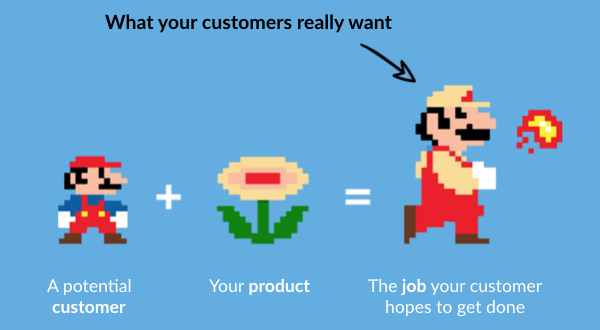
Here is how the Christensen Institute explains the framework:
“The jobs-to-be-done framework is a tool for evaluating the circumstances that arise in customers’ lives.
Customers often buy things because they find themselves with a problem they would like to solve. With an understanding of the “job” for which customers find themselves ‘hiring’ a product or service, companies can more accurately develop and market products well-tailored to what customers are already trying to do.”
Once you get clarity on why someone wants to buy something, it makes it easier for you to create the right products.
Let’s jump on some examples to make this more concrete.
Example 1: A good JTBD example: Milkshake Marketing
I first came across the jobs-to-be-done framework through this example:
The Milkshake Marketing case study.
I use it often as it helps explain the power of understanding how jobs emerge in people’s lives. It’s about customers who “hire” milkshakes for breakfast in fast-food restaurants.
You can watch this video that summarises it:
The Milkshake example comes from the research of Clay Christensen. It’s about a fast-food company. The company used the job framework to create milkshake recipes tailored to the needs of their customers.
By doing customer interviews, they realised that people “hired” milkshake on the morning for a surprising reason.
The insight: Milkshakes were hired instead of a bagel or doughnut because it was relatively tidy and appetite-quenching, and because trying to suck a thick liquid through a thin straw gave customers something to do while driving during their boring commute.
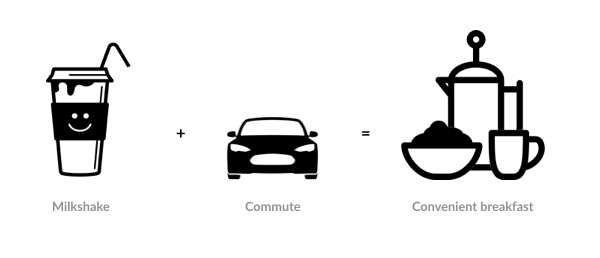
The new value proposition: Understanding the job to be done, the company could then respond by creating a morning milkshake that was even thicker (to last through a long commute) and more interesting (with chunks of fruit) than its predecessor.
The example is good for three reasons:
- The reason why customers buy milkshakes for breakfast is surprising;
- It shows the importance of understanding customers’ jobs in a particular context;
- It illustrates how jobs can be used to segment a market.
To put this into practice, read this article on templates that help you a value proposition.
Example 2: Using jobs to write a book tailored to your readers
In the functions of product and marketing, people share an obvious job to be done:
“When I’m creating or designing a product, I need to be able to understand what my customers or users will really want.”
At a higher level, they may want to understand their target market for various reasons:
– a startup founder is motivated by the success of her company;
– an employee wants to share good data as he may be hoping for a raise.

At a lower level, they may have different jobs to get done:
– a market researcher wants to draw a good picture of the market for his client;
– a product manager is trying to reduce the churn rate;
– a designer has to create the user interface of a new app;
– a marketer is working on a new campaign to acquire new customers.
Understanding this led me to write a new book to help them do that.
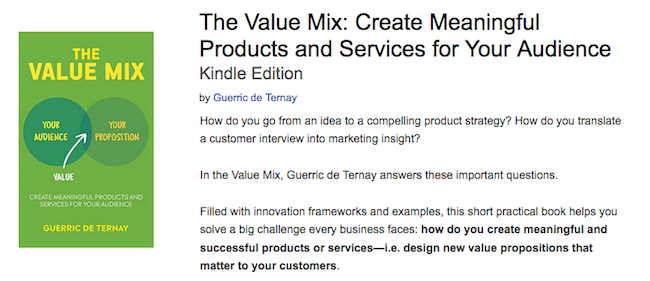
Insight: After numerous customer interviews, I understood that all of these people needed to share a common framework to analyse and segment their market and create their product strategy.
Value proposition: The Value Mix came as a way to do exactly that. The book digs into a few tools you can use to understand your customers and what they want. It then explains how to frame a coherent product strategy.
Example 3: Photoshop vs Instagram: When a new job to be done arises
The Photoshop/Instagram example is a good way to explains the importance of jobs.
Both products are photo-editing software.
Same product category. But, actually, they allow users to achieve two different jobs.
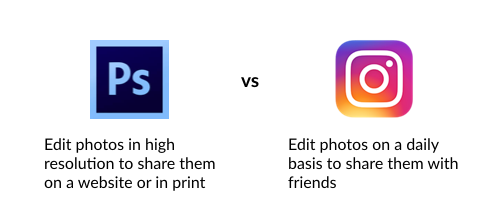
The insight: Smartphones users take photos all the time. But not all of their photos are high-quality shots that deserve hours of editing in Photoshop.
The opportunity: Smartphone users want that helps them do the job (editing pictures) quickly and easily.
This why today, Photoshop and Instagram are used for two different jobs:
- Photoshop: For professional photographers who want to edit high-quality shots;
- Instagram: For amateurs who want to edit and share beautiful everyday pictures.
Example 4: The iPod and the difference between “Jobs” and “Benefits”
Here’s another example I use to explain the difference between a “job” and a “benefit”.
When Apple released the first iPod. It used a catchphrase that has become a marketing case study:
“1,000 songs in your pocket.”
At the time, people didn’t know what the feature “5 GB” meant for them. By translating “storage size” into “number of songs stored”, everyone could clearly see the benefit.
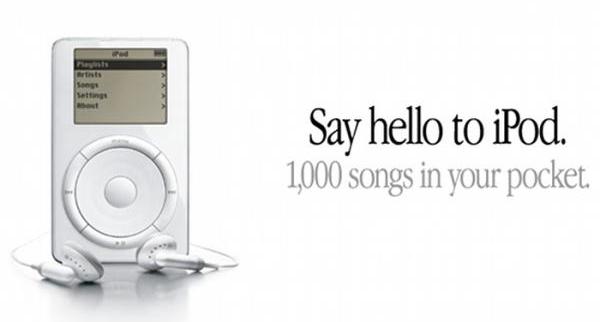
What’s the difference between a job to be done and a benefit?
In a recent conversation, I had with Karen Dillon, author of Competing Against Luck, a book about the jobs-to-be-done framework, she clarified the meaning of a job vs. a benefit:
“So features and benefits are geared to solving a job. But if they aren’t well matched to the job someone is hiring a product or service to do, it doesn’t matter how good they are, they won’t attract and keep those people struggling with a job.”
The job is about the customer.
The feature + benefit are about the product.
I dig into that idea in The Value Mix. Have a look at how it can help you create successful products.
An example of when we “hire” an iPod
An example of job to be done that we have is to motivate ourselves with music when we go running.
In that context, we were used to hiring a big Walkman. See Monica from Friends doing this in 1994:

The job remains the same in 1994 and in 2001—when the iPod was released. People still wanted to achieve the same progress: to motivate themselves with some music when they go running.
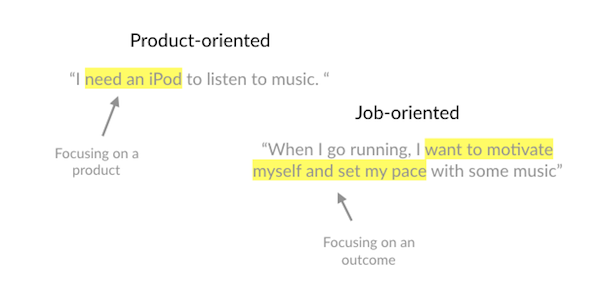
But in the iPod offers better features, which means better benefits.
Overall, the user experience is better tailored to do the job of feeling motivated when you go running. The iPod is smaller, easier to use, and it allows you to have more than one CD (12 songs) on your playlist. You don’t have to listen to the same music over and over again or be bothered to change the CD.
Here’s a summary of the example:
– Feature: 5 GB
– Benefit: 1,000 songs your pocket
– Context: when you go running
– Job to be done: you want to motivate yourself with some music
Example 5: JTBD in Retail Banking
The role of banks in our world sounds really complex. Indeed, banks offer so many different financial products with lengthy T&Cs.
So how can the jobs-to-be-done framework help us?
The framework allows us to go back to the first principle—i.e. what is the essence of what banks do.
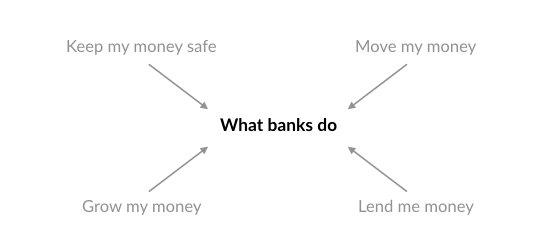
If you think about it, banks help us achieve one of four kinds of jobs:
- Keep my money safe (e.g. saving account)
- Move my money (e.g. transfer, debit card)
- Grow my money (e.g. ISA in the UK, IRA in the US)
- Lend me money (e.g. student loan, credit card)
At the most basic level, any bank helps us do these things.
Identifying these core jobs has allowed companies like Wealthfront, Revolut, or TransferWise to succeed. They’ve focused on one specific job and have done it very very well!
—
More resources and examples about jobs to be done:
- https://leanpub.com/value-mix/
- https://medium.com/the-job-to-be-done/replacing-the-user-story-with-the-job-story-af7cdee10c27#.ca7hfuvbp
- https://medium.com/the-founders-blog/when-jobs-to-be-done-backfires-f70dd0ac4498#.q7j13bvke
- https://medium.com/@zbigniewgecis/8-things-to-use-in-jobs-to-be-done-framework-for-product-development-4ae7c6f3c30b#.y0ovaqula
- https://jtbd.info/know-the-two-very-different-interpretations-of-jobs-to-be-done-5a18b748bd89